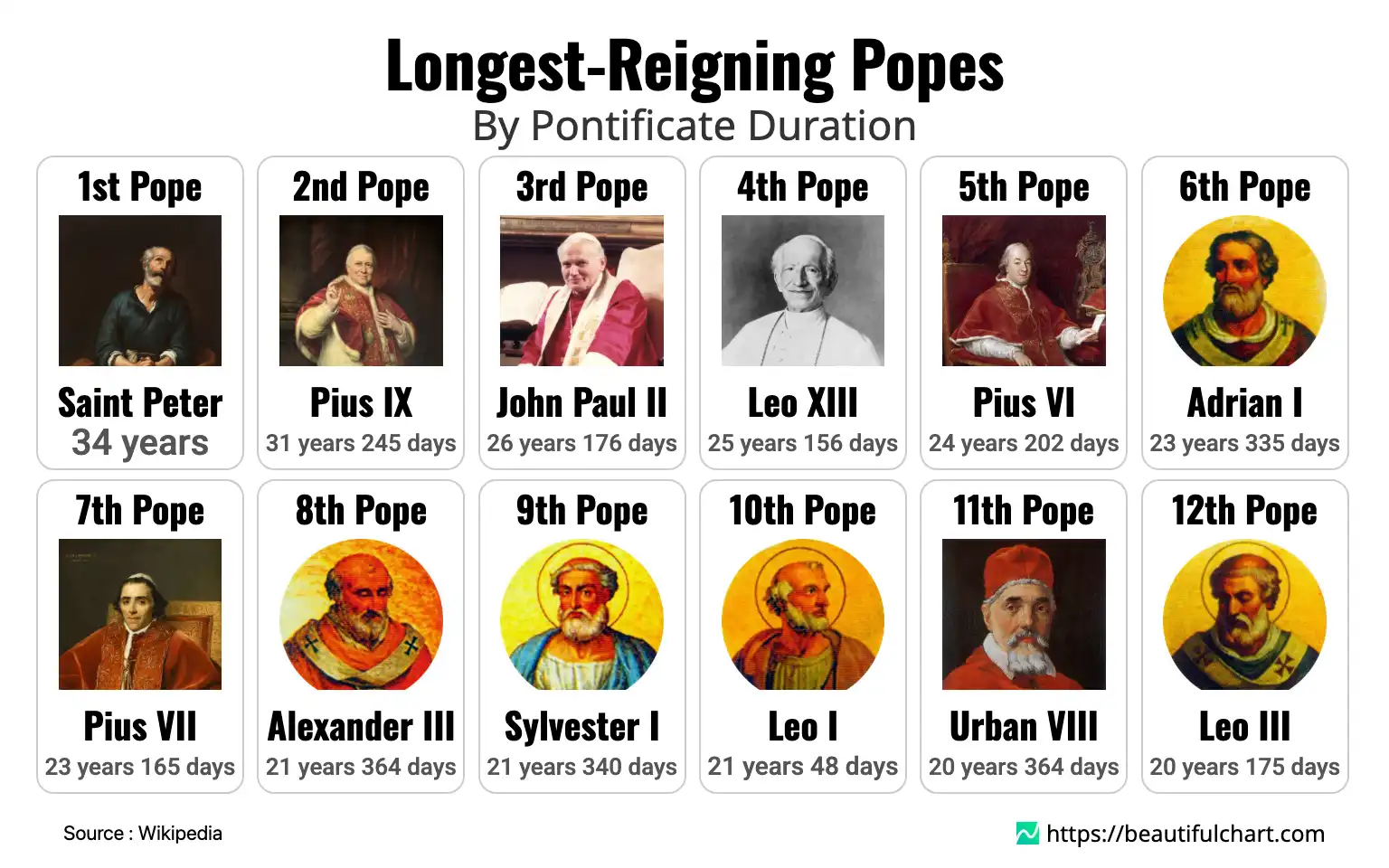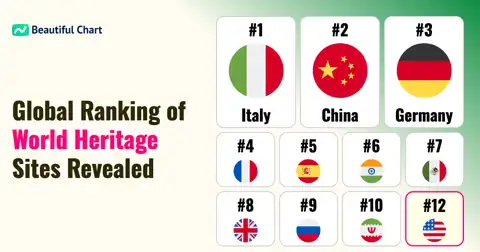The history of the papacy features pontificates of remarkable length, with a select few popes guiding the Catholic Church for over two decades. Saint Peter is traditionally held to have had the longest reign, extending over 30 years. Following him are figures like Pius IX and John Paul II, whose long tenures in the 19th and 20th centuries, respectively, left indelible marks on the institution and its global followers. This ranking highlights the popes whose exceptionally long service distinguishes them across nearly two millennia of papal history.

The Papacy refers to the office and jurisdiction of the bishop of Rome, the Pope, who is the head of the Catholic Church. The term is derived from the Latin 'papa,' meaning 'father.' The Pope serves as the spiritual successor to Saint Peter, who is considered the first Pope in Catholic tradition.
The leadership of the Catholic Church has seen hundreds of pontiffs, but only a small fraction have held the position for more than two decades. The duration of a pope's reign is not merely a historical footnote; it often correlates with periods of significant transformation, doctrinal definition, and institutional change. Examining the longest pontificates offers a unique perspective on the evolution of the papacy and its response to the challenges of its time.
The Foundations of Papal Longevity
The concept of a long reign begins with the very first pope, Saint Peter. Tradition holds that his ministry in Rome lasted for more than three decades, establishing a benchmark that has remained unmatched for nearly two millennia. While historical records from this era are sparse, his long tenure is foundational to the idea of the papacy as a lifelong commitment and a source of stable, continuous leadership for the nascent Christian community. This extended period allowed for the initial establishment of the Church in the heart of the Roman Empire.
Modernity and the Long Reign
In the modern era, long pontificates have often coincided with periods of immense social and political upheaval. The 31-year reign of Pius IX, the longest since Saint Peter, is a prime example. His time as pope saw the loss of the Papal States, the rise of Italian nationalism, and the declaration of papal infallibility at the First Vatican Council. His lengthy tenure allowed him to shape the Church's response to modernity, albeit in a way that was often resistant to the political and intellectual currents of the 19th century. Similarly, the 26-year pontificate of John Paul II occurred during the final decades of the Cold War and the dawn of the new millennium. His extensive travels, prolific writings, and role in the collapse of communism in Eastern Europe demonstrated the global influence a long-serving pope could wield in the contemporary world. His reign was instrumental in defining the Church's role in an increasingly interconnected yet ideologically divided world.
The Impact of Enduring Leadership
Popes with extended reigns, such as Leo XIII and Pius VI, have had profound and lasting impacts on the Church's doctrine, governance, and relationship with the wider world. Leo XIII, who reigned for 25 years, is renowned for his development of modern Catholic social teaching with the encyclical Rerum Novarum. This was a landmark document that addressed the condition of the working classes and set a course for the Church's engagement with social justice issues. In contrast, the 24-year reign of Pius VI was marked by conflict with the French Revolution and Napoleon Bonaparte, a struggle that tested the papacy's temporal and spiritual authority. These long tenures provided the stability and time necessary to formulate comprehensive responses to the defining issues of their eras, leaving legacies that continue to influence the Catholic Church today.
Key Takeaways
The Significance of Long Pontificates
- Long reigns often coincide with pivotal moments in history, allowing popes to shape the Church's response to major social, political, and religious transformations.
- The longest pontificates are not concentrated in any single era, with representatives from the early Church, the modern period, and contemporary times.
- Popes with extended tenures have left lasting legacies through doctrinal pronouncements, social teachings, and their navigation of political conflicts.
Notable Long-Serving Popes
- Saint Peter's traditional reign of over 30 years stands as the longest in papal history, establishing a foundational model of leadership.
- Pius IX's 31-year reign is the longest verifiable pontificate, a period defined by the Church's struggle with modernity and the loss of temporal power.
- John Paul II's 26-year tenure had a profound global impact, contributing to political changes in the 20th century and shaping the Church for the new millennium.
Top Ranking
#1 Saint Peter undefined
Saint Peter, traditionally regarded as the first Pope, holds the distinction of having the longest pontificate in the history of the Catholic Church. While precise dates are subject to historical debate, his leadership of the early Christian community in Rome is held by tradition to have lasted for approximately 34 years, from the time of Christ's death until his own martyrdom. As a foundational figure, his long tenure was crucial in establishing the nascent Church in the capital of the Roman Empire. His role as the "rock" upon which the Church was built, as described in the Gospel of Matthew, and his extended ministry set a precedent for papal authority and continuity that has echoed through the subsequent two millennia of Church history.
#2 Pius IX undefined
Pius IX, born Giovanni Maria Mastai Ferretti, had the longest verifiable reign in papal history, serving for 31 years and 245 days from 1846 to 1878. His pontificate is one of the most consequential of the modern era, marked by a deep-seated struggle between the Church and the forces of liberalism, nationalism, and modernism. He convened the First Vatican Council in 1869, which famously defined the dogma of papal infallibility. His reign also witnessed the final loss of the Papal States and the city of Rome to the newly unified Kingdom of Italy, an event that effectively ended the papacy's temporal sovereignty and led him to become the first "prisoner of the Vatican." His long tenure allowed him to consolidate ecclesiastical power and define the Church's posture toward the modern world for generations.
#3 John Paul II undefined
John Paul II, born Karol Józef Wojtyła, served as Pope for 26 years and 176 days, making his the third-longest pontificate in history. His reign, from 1978 to 2005, was one of the most visible and influential of the 20th century. A native of Poland, he was the first non-Italian pope in 455 years. His extensive travels, covering 129 countries, transformed the papacy into a truly global institution. He played a significant role in the collapse of communism in his native Poland and across Eastern Europe. A prolific writer and charismatic figure, he authored numerous encyclicals and apostolic letters that shaped Catholic teaching on a wide range of moral and social issues, leaving a profound and lasting impact on the Church and the world stage.
#4 Leo XIII undefined
Pope Leo XIII, born Vincenzo Gioacchino Raffaele Luigi Pecci, had a pontificate that lasted for 25 years and 156 days, from 1878 to 1903. He is best known for his intellectual contributions to the Church and his efforts to reconcile Catholicism with modernity. His most famous and influential work was the 1891 encyclical Rerum Novarum (Of New Things), which established the foundations of modern Catholic social teaching. It addressed the plight of the working class, condemned both unrestricted capitalism and socialism, and advocated for workers' rights and the formation of unions. Leo XIII's long reign allowed him to foster a renewal of Thomistic philosophy, open the Vatican Archives to scholars, and chart a course for the Church's engagement with the pressing social and political issues of the late 19th century.
#5 Pius VI undefined
Pius VI, born Count Giovanni Angelo Braschi, reigned for 24 years and 202 days, from 1775 to 1799. His pontificate was dominated by the immense challenges posed by the Age of Enlightenment and the French Revolution. He condemned the Civil Constitution of the Clergy, a revolutionary decree that sought to subordinate the French Church to the state, leading to a major schism. His opposition to the revolution ultimately led to his downfall. In 1798, French troops under Napoleon Bonaparte occupied Rome, declared a Roman Republic, and took Pius VI prisoner. He was exiled to France, where he died a captive, a dramatic and tragic end to one of the longest and most tumultuous reigns in the Church's history.
| Rank | Name | Indicator | Subindicator |
|---|---|---|---|
1st Pope | 34 years | 30 ~ 64 | |
255th Pope | 31 years 245 days | June 1846 ~ February 1878 | |
264th Pope | 26 years 176 days | October 1978 ~ April 2005 | |
256th Pope | 25 years 156 days | February 1878 ~ July 1903 | |
250th Pope | 24 years 202 days | February 1775 ~ August 1799 | |
95th Pope | 23 years 335 days | February 772 ~ December 795 | |
251st Pope | 23 years 165 days | March 1800 ~ August 1823 | |
170th Pope | 21 years 364 days | September 1159 ~ August 1181 | |
33rd Pope | 21 years 340 days | January 314 ~ December 335 | |
45th Pope | 21 years 48 days | September 440 ~ November 461 | |
235th Pope | 20 years 364 days | August 1623 ~ July 1644 | |
96th Pope | 20 years 175 days | December 795 ~ June 816 | |
243rd Pope | 20 years 122 days | November 1700 ~ March 1721 | |
260th Pope | 19 years 227 days | March 1939 ~ October 1958 | |
15th Pope | 18 years 358 days | 199 ~ December 217 | |
176th Pope | 18 years 195 days | January 1198 ~ July 1216 | |
160th Pope | 18 years 166 days | August 1099 ~ January 1118 | |
196th Pope | 18 years 124 days | August 1316 ~ December 1334 | |
37th Pope | 18 years 77 days | October 366 ~ December 384 | |
59th Pope | 18 years 75 days | March 537 ~ June 555 |





